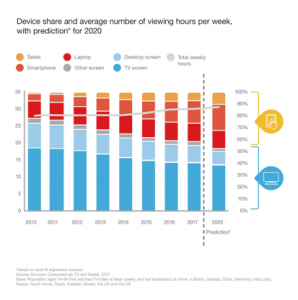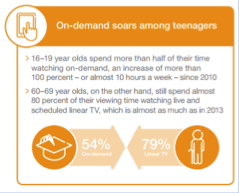
After more than 40 years of operation, DTVE is closing its doors and our website will no longer be updated daily. Thank you for all of your support.
Mobile-first means opportunities for operators
 Operators need to cater for the growing trend towards mobile-first viewing, writes Arpad Jordan, head of media processing and delivery at Ericsson.
Operators need to cater for the growing trend towards mobile-first viewing, writes Arpad Jordan, head of media processing and delivery at Ericsson.
Mobile consumption is exploding. Consumers are not only shifting where they are watching, but also on which device to consume certain types of content.
They are now rating their user experience through the relative value of watching video on different screens. This has prompted new challenges to the industry to find fresh ways to increase the accessibility of TV and video and make it more suitable to a broader range of devices.
Mobile viewing will be led by the smartphone
 Today, we can see that viewers are watching video across their tablets, their laptops and above all else, their smartphones, which continues to grow in penetration and has taken the role of the consumers’ all-in-one favourite device. They are now a fundamental part of daily consumer viewing habits
Today, we can see that viewers are watching video across their tablets, their laptops and above all else, their smartphones, which continues to grow in penetration and has taken the role of the consumers’ all-in-one favourite device. They are now a fundamental part of daily consumer viewing habits
As this year’s Ericsson ConsumerLab TV and Media findings reveal, around 70% of consumers watch TV and video on a smartphone today – twice as many as in 2012. Furthermore, smartphones now make up a fifth of total viewing, with approximately six hours per week spent watching TV and video on the device. Looking forward into the future, this trend is only going to increase further. By 2020, 50 percent of all viewing is expected to be done on a mobile screen, of which half will be on a smartphone alone.
Millennials demanding content on their terms
 The data also reveals that a lot of the consumer shift is happening amongst younger age groups. For instance, more than 60 percent of their TV and video viewing hours are spent on a mobile device. This age group also spends more than half of their time watching on-demand content, an increase of more than 100% – or almost 10 hours a week – since 2010. 60-69 year olds, on the other hand, still spend almost 80% of their viewing time watching live and scheduled linear TV, which is almost as much as in 2013.
The data also reveals that a lot of the consumer shift is happening amongst younger age groups. For instance, more than 60 percent of their TV and video viewing hours are spent on a mobile device. This age group also spends more than half of their time watching on-demand content, an increase of more than 100% – or almost 10 hours a week – since 2010. 60-69 year olds, on the other hand, still spend almost 80% of their viewing time watching live and scheduled linear TV, which is almost as much as in 2013.
Demand for content on the consumer’s own terms is intensifying as our industry transforms towards an age of on-demand, over-the-top video viewing, which has become increasingly personalised and interactive. We are moving towards the generation of mobile-first, where everything that is on a screen is increasingly connected to a broadband IP network, with the internet becoming the dominant delivery medium.
New solutions for anywhere, anytime viewing
Now, with the introduction of software-defined networks, video encoding and cloud capabilities, service providers have the potential to offer consumers the content they want, including when and how they want it. As such, emerging technologies are helping to bring the number of formats and types of formats to an all-time high. We have already undergone the transition from standard definition to high definition and now we have many new immersive viewing experiences that could be added to next generation television, including higher spatial resolution of 4K TV and High Dynamic Range (HDR).
All of these attributes together form a much more immersive viewing experience but they also mean that there needs to be changes in the workflows to accommodate them. The more flexible the workflows are in the interfaces for doing that, the more you can accomplish.
Workflow for mobility
These trends are prompting service providers to focus on the fundamental technologies needed to deliver video content that negates the challenges of mobile viewing while supporting its inherent benefits.
One of the biggest trends is the use of scalable cloud based platforms streamlining the media processing workflows needed to make content suitable for mobile first audiences. The advantages of platforms such as Ericsson’s MediaFirst Video Processing that allow a software controlled and highly scalable solution, means that tasks such as compression and stream processing along with personalisation elements can dynamically adapt content to different device constraints and mobility profiles.
By unifying these processes within an integrated platform, mobile users can gain access to the growing list of advanced features such as cloud DVR, on-demand and time-shifted services that are tailored in terms of resolution and frame rate to the limitations of device screens and network bandwidth. Our Video storage and Processing Platform (VSPP) solution, for instance, is designed to reduce the complex, costly and time-consuming process of delivering these next generation TV experiences.
Is the industry ready for 5G?
This visionary platform approach offered by MediaFirst Video Processing will become even more valuable as new mobile technologies start to reach maturity. As consumption increases, in order to deliver the ultimate video quality anywhere, technology enablers such as 5G will be increasingly important, from the home and the workplace, all the way through to densely populated live events or public transport. 5G will maximise the consumer experience further, helping to accelerate the development of new services in all makers, as well as proving hugely beneficial to delivering live TV at scale.
By enabling consumers to realise the types of TV experiences they are demanding, content owners, broadcasters, and pay-TV service providers can break further boundaries and drive a plethora of new and differentiating revenue opportunities.

